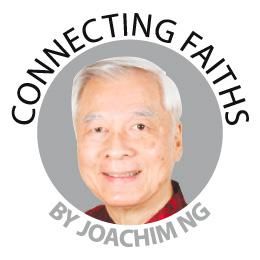MILLIONS of citizens would have failed to detect the significance of a statement issued by two big ethno-religious political parties last month expressing their stand over usage of a West Asian term for God by people of another faith. Is it okay for politicians to wade into religion?
Malaysians who are schooled in the idea that religion and politics ought to be kept separate will insist that politicians stay out of this. However, scholars of antiquity well-versed in the subject know that politics and religion have always been intertwined.
If you look at the DNA of every human being, there are two strands woven around each other. Similarly, religion and politics are two strands of civilisation that support each other. Religion is the anchor for civilisation, devising a uniform set of beliefs and practices to unify the diverse spread of a civilisation’s reach.
As for the other strand, politics, with its structures and institutions, is the device for governing the huge masses of people that comprise a civilisation. In times of antiquity, the king and priest always stood together side by side.
The word priest is used by scholars in a broad sense to mean a person wielding official religious authority, and priesthood is the class that wields such authority. The priest confirms that the ruler is appointed by God and the king ensures that all the people accept the religious belief system.
The priesthood may define the word for God, so as to draw boundaries around its meaning. This has clearly happened. The king will then enforce this definition and forbid non-believers from using the word.
That is par for the course in times of antiquity when the flow of information was in the hands of kings and priests. It is not quite the same today. What is the most pressing concern of Malaysians? The lack of unity in pursuing what is good for the nation as a whole.
Belief in God is supposed to bring unity, and yet we let the word itself divide us. Doesn’t “God” mean the same thing in any language? No, it’s not like “water” as some think. Water is the same whether you call it sui (Mandarin), air (Malay) or mizu (Japanese) because in all cases it is the substance H20.
However, “God” is not a substance but a conceptual notion. As God lies beyond the realm of the presently knowable, the best we can do is to formulate some ideas about God. These ideas differ from religion to religion, and hence, the words that translate into “God” acquire shades of meaning that can range like the colours of a rainbow.
The definition of any word for God incorporates elements that reflect the ethnic, geographical, sociopolitical and functional concerns of a civilisation. While Islam has developed one concept of God, Christianity holds on to another and uses the term “Son of God” freely.
This term, “Son of God”, was immensely popular throughout the ancient civilised kingdoms of the world, especially in civilisations of the vast West Asia-North
Africa-Mediterranean Europe (WaNaMe) region before 570 CE.
In the anthropomorphic cultural milieu of that region, God was defined as having characteristics resembling human qualities, and conversely some humans possessed divine nature.
For several thousand years, from the oldest civilisations up till the last days of the Roman Empire, what was the source of political power for the large assortment of kingdoms in WaNaMe?
Despite their vast cultural diversities and huge range of languages, all these ancient kingdoms drew their political power from a common source – God and the Son of God.
Which man could be nearer to God than the Son? Hence, to secure absolute loyalty, obedience and compliance to his laws, the ruler as the highest person in a civilisation had to be the Son of God.
The ancient kings of Israel were styled as the firstborn Sons of God. The Jewish tradition, however, recognises that the Son of God is not literally the Son of God, and so the king is not divine but entirely human.
Other kings had no such reservations. All the Egyptian pharaohs, if they were males, were Sons of Re and Divine. Re is the name for God in ancient Egypt. If you know Mandarin, you know that Re gives light, energy and power.
Perseus of Greece and Romulus of Rome were also the Sons of God. Orpheus, the Greek poet and musician, was a Son of Apollo the God. The most powerful Son of Apollo was Caesar Augustus, the first Roman emperor who was born of a Virgin Mother.
As Time magazine noted in a December 2004 cover article where it touched on Roman imperial grandeur, the emperor was “Son of God, Lord, Saviour of the World, and the One who has brought peace on earth”.
As far back as 1988, Britain’s well-respected daily newspaper Financial Times had in its Christmas issue that year acknowledged the widespread belief in human divinity, starting from the earliest days of civilisation in Iraq.
In that issue, it printed an image dating back to 1500 BCE of the Virgin Mother Goddess Ishtar with her child, who was both man and God. Readers initially thought it was a drawing of Jesus and his mother Mary.
The Chinese regarded their emperor as the “Son of Heaven” with a divine mandate to rule wisely. But the Japanese remain torch-holders. To this day, Japan maintains that its imperial line is descended from the Sun Goddess Amaterasu. This divinity has enabled the Japanese people in wartime to instantly solidify as one bloc at the emperor’s command. Who would disobey a God?
How did God produce a Son? Easy. Across the whole of Asia from the Mediterranean to the Pacific, ancient myths proclaim the universe to be made from the body of God, who is both father and mother of creation. What are human beings, then? Children of God.
Some religious authorities feel that the term “Son of God” implies polytheism but a scholar of antiquity will smile and say: “Anything goes in politics.”
The point is not whether there is really a Son of God but whether the use of this metaphor effectively garners wide unconditional support for the title-holder. Caesar found it useful.
The writer champions interfaith harmony.
Comments: letters@thesundaily.com













